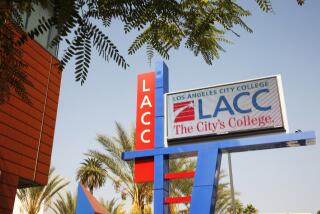Study Laments Lack of Courses at Many Schools : Reviving the Humanities: Profiles of 3 Colleges
- Share via
All too often today, a panel of leading educators fears, college degrees are awarded for little more than living in the same place for four years while avoiding an education.
Required liberal arts courses have all but disappeared, turning college into “a self-service cafeteria through which students pass without being nourished,” the National Endowment for the Humanities study group said in a recent report.
History, literature, philosophy and language majors are endangered species. Curricula that “pay off” in the job market are in demand, and students just don’t think that Aristotle, Shakespeare, Mozart, Voltaire and Freud pay off.
Most ‘Shortchanged’
“Most of our college graduates remain shortchanged in the humanities,” NEH Chairman William J. Bennett wrote in the 31-member panel’s recent report.
“The fault,” he said, “lies primarily with those of us whose business it is to educate these students.”
But not everyone in the business is at fault. The panel cited three “bright spots” as examples of American colleges that are fighting the “drift toward curricular disintegration.”
Here are capsule profiles of the three schools. One is public, one Catholic and the third a two-year community college: Brooklyn College in New York, St. Joseph’s College in Indiana and Kirkwood Community College in Iowa.
There is a lot of pride at Brooklyn College--justifiable pride in a school with annual tuition and fees of $1,306 that stands just 45 minutes by subway from Broadway and is known as “the poor man’s Harvard.”
Novelist Irwin Shaw is an alumnus, as are 300 corporation heads. About 450 graduates are listed in “Who’s Who of America,” and the school ranks ninth in the country in graduates who earn doctoral degrees.
There is so much justifiable pride in Brooklyn College that its president, Robert L. Hess, can easily be excused for taking the nickname just one step further.
“I like to think of Harvard as the rich man’s Brooklyn College,” Hess said.
Brooklyn, a part of the City University of New York, requires all its students to master a core of courses laced with the kinds of humanities offerings the NEH panel recommends.
Every Brooklyn graduate studies art, music, political science, literature, and history, attains proficiency in a language, tackles computer science, biology, chemistry, mathematics and even takes courses in values.
The mandated courses fill just over one-quarter of the student’s college program.
“We believe a common core helps prepare people for life because of flexibility in their careers and changes in specialties,” said Ethyle Wolfe, provost and previously dean of humanities at the college.
Hess and Wolfe are co-architects of the core, and such strong believers in its principles that they take time from their administrative duties to teach.
The president teaches three hours a week in “Shaping of the Modern World.” The provost teaches a course in classics.
Students Sometimes Balk
Hess says there are students who balk at spending so much time on required courses. The answer to their objections, he says, is an easy one.
“As faculty and administrators, we have responsibility to let you know that some things are better than others,” he said. “If they complain, I tell them that when they come out of Brooklyn College they will be as educated or more educated than their colleagues at Ivy League colleges.”
The president of St. Joseph’s College doesn’t worry about warnings that American higher education had better get back to basics.
That’s because St. Joseph’s rediscovered the fundamentals--art, music, literature, philosophy, history, theology--more than 15 years ago.
St. Joseph’s is a small school in a tiny, rural northwestern Indiana county seat of fewer than 5,000. Its tuition, room and board charges are also relatively tiny--$7,460 a year. But its commitment to the humanities is strictly big time.
Its 933 undergraduates often are career oriented. Nearly 40% major or minor in business.
But every last one, in at least one course every semester, is also exposed to great thinkers and doers who shaped the world in which they will conduct their business.
“The idea is that there is a common body of knowledge that all of us must have to appreciate where we are and how we got there,” said the Rev. Charles Banet.
Banet, president for the last 20 years of the school founded in 1891 by priests of the Society of Precious Blood, is the man most responsible for St. Joseph’s Core Curriculum, introduced in 1969.
Even before he became president, Banet was convinced that higher education had taken a wrong turn and was over-stressing preparation for the professions. He began considering how pre-professional and general education could live together.
Period of Dissent
The student unrest of the 1960s--demands for relevancy, fewer requirements and wider choices in course offerings--helped fine-tune his thinking and that of the faculty and consultants who designed the core.
“The kids were saying, ‘Let’s ditch this--what’s it got to do with my life?”’ Banet said. “We were trying to resist that, but we also felt we had to make what we were doing relevant.
“If you were going to be an engineer, you wanted to get out there and start measuring the distance between light poles,” he said. “If you were going to be an accountant, you wanted to start adding numbers in columns. You didn’t want to read Plato.”
Pursue Primary Interests
So St. Joseph’s rejected the idea of forcing students to devote their freshman and sophomore years almost entirely to humanities courses before letting them begin solid work in their majors.
Instead, the core program lets them pursue their primary interests right away. But it also reserves time throughout the college career for the humanities.
First-semester freshmen take “The Contemporary Situation,” an interdisciplinary survey of ideas and concerns since World War I and how they have affected today’s world.
“You can’t get more relevant than that,” Banet said. “Then we go back in time to see why it is relevant.”
The impact of the past on modern man is traced through the “Roots of Western Civilization,” “The Christian Impact on Western Civilization,” “Man and the Universe,” “Non-Western Studies,” and “Toward a Christian Humanism.”
In all, there are eight courses that St. Joseph’s students are required to take--no matter what their major.
“Our students study cultures other than their own,” said Banet, “affording them an understanding of how their tradition fits in with the larger world. And their study of their own tradition deepens their understanding of their own society and intellectual legacy.”
Tucked away on the campus of Iowa’s largest community college, somewhere between the computer room, auto mechanics garage and food service lab, is a group of teachers proving that art, literature and music aren’t just for four-year schools.
Faculty in the revised humanities program at Kirkwood Community College are ecstatic over the national recognition afforded them in the NEH report.
They are even more pleased that the NEH awarded Kirkwood a $300,000 grant to help them expand their offerings.
Taken by Surprise
“We were surprised when we hit the big prize,” instructor Liz Anderson said. “We always thought the four-year schools got the big money.”
The grant and national attention follow years of unnoticed faculty initiative to revitalize the college’s humanities program.
Kirkwood has increased the number of humanities courses required to meet degree requirements and introduced two new courses designed to open students’ eyes to cultural possibilities.
“We teach a framework of thought, so they analyze new things and then pass judgment,” English instructor Katheryn McKay said. “Usually, students pass judgment before they know what they’re judging.”
In these new courses, students are likely to read classical Greek philosophy one day and attend a symphony concert the next. An opera singer’s in-class appearance may be followed by a session on architecture.
After this kind of exposure, Kirkwood graduates can transfer to the nearby University of Iowa or to a liberal arts college with a solid foundation in the humanities.
Those who choose to go immediately into the job market with the vocational training that is their primary purpose for coming to Kirkwood still have a background in the finer things in life.
“You don’t have to be a so-called ‘artsy’ person to like art,” history instructor Hanna Weston said. Kirkwood graduates prove it.
Anderson says she spotted one of her former pupils in the season ticket seats at the local symphony orchestra hall. Another student who loudly protested a class museum visit later announced he was taking his family to Kansas City for a special Indian exhibit.
The revitalized program is run by the teachers who were the last to receive permanent classrooms on Kirkwood’s relatively new campus.
College President Bill Stewart said his appreciation for their initiative is heightened by the fact that the humanities department toiled for so long in a wood-frame building east of the modern brick campus that houses vocational and technical programs.
Most of the NEH grant money will go toward teacher education and research projects, designed to broaden the instructors’ knowledge.
“To be a renaissance teacher,” Stewart said, “you need to be a renaissance person.”
More to Read
Sign up for Essential California
The most important California stories and recommendations in your inbox every morning.
You may occasionally receive promotional content from the Los Angeles Times.













